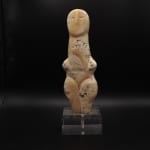Predynastic Fertility Figure, 4000 BCE - 2500 BCE
Alabaster
27.1 x 8.7 x 3.6 cm
10 5/8 x 3 3/8 x 1 3/8 in
10 5/8 x 3 3/8 x 1 3/8 in
LI.3402
Further images
A culture very much related to that of the Cyclades existed in Egypt during the Predynastic period. A preference for highly schematic and reductive figurines, predominantly female, is also very...
A culture very much related to that of the Cyclades existed in Egypt during the Predynastic period. A preference for highly schematic and reductive figurines, predominantly female, is also very common to both. These female figurines represent in all probability the Mother Goddess and are linked to notions of fertility, while their schematic simplicity is typical of the prehistoric cultures, when they were made in a variety of materials. The fact that such figurines have been unearthed in urban surroundings and small domestic shrines suggests that they were used for daily worship purposes.
These sculptures represent some of the earliest attempts to represent human figures.
The present figurine has abstract iconographical characteristics, focussed on prominent hips in an hour-glass figure, schematic neck , and almost absent arms. Simplified yet elegant expression of the pubic triangle continuing in a cut symbolically dividing the two legs and two lines under the breasts. The portrayal of the pubic triangle clearly denotes then link of this figurine to fertility cults. The face is essentially circular, with a ridge marking the nose and eyes rendered as fissures. The smooth flat surface is devoid of any detail, featuring two wings/arms either side of a ‘tear-drop’ shaped body. The only interruption to the surface is the beak-like protrusion from the centre of the face.
The appeal of this figure, along with its exceptional rarity, is in its quintessentially minimalistic character. This is an artefact almost 6000 years old and yet uniquely appealing to the contemporary eye and taste.
This is an artefact of truly outstanding museum quality, befitting the most distinguished collections and the most discerning collectors.
These sculptures represent some of the earliest attempts to represent human figures.
The present figurine has abstract iconographical characteristics, focussed on prominent hips in an hour-glass figure, schematic neck , and almost absent arms. Simplified yet elegant expression of the pubic triangle continuing in a cut symbolically dividing the two legs and two lines under the breasts. The portrayal of the pubic triangle clearly denotes then link of this figurine to fertility cults. The face is essentially circular, with a ridge marking the nose and eyes rendered as fissures. The smooth flat surface is devoid of any detail, featuring two wings/arms either side of a ‘tear-drop’ shaped body. The only interruption to the surface is the beak-like protrusion from the centre of the face.
The appeal of this figure, along with its exceptional rarity, is in its quintessentially minimalistic character. This is an artefact almost 6000 years old and yet uniquely appealing to the contemporary eye and taste.
This is an artefact of truly outstanding museum quality, befitting the most distinguished collections and the most discerning collectors.











